
Late summer in Northern Ontario has weather that humans were meant to live in.
Warm, but not hot, during the days and cool, crisp nights.
A perfect escape from the heat and humidity south of the border. Yes, that’s how Canadian’s refer to The United States.

Our mission north had a two-fold agenda, enjoy the climate, and finally find a moose for Veronica.
She’s never seen one in real life, and after our attempts to remedy that situation in New England, The U.P. of Michigan and the Northern Rockies, she has decided that they are mythical creatures. Like unicorns.
So we set out with no particular itinerary other than that I was determined that we would not return to The States until I showed her a moose.
Crossing into Canada at Sault Ste. Marie, we headed east along the north shore of Lake Huron.

We pulled BAMF into several water-side, beautifully forested campsites on our way, places like Blind River, Elliot Lake, and Mississagi Provincial Park, but nary a sign of a moose.
We figured we should go farther north. Up where only the hardiest souls, and a whole lot of moose, live.

After a hundred miles without seeing another human being we reached the little crossroads of Chapleau.
We were glad to see some civilization, and it was about time to call it a day, but we had seen a sign for The Golden Route Lodge that advertised it as Pure Raw Canada, so we turned west and forged on a few more miles.

Camped right on the banks of Sideburned Lake, near the sign that announced we had crossed into The Arctic Ocean Watershed, we didn’t see anything that could dispute the claim of pureness and rawness.



Dinner of pork chops, hand cut on site, and veggies from the garden out back, plus a couple Molsen Canadians sealed the deal. So we asked about moose.
There was some hemming and hawing, excuses that Veronica calls moose-cuses, about how it might be too dry or the wrong time of year or whatever, but we were promised that we could see a fox in the morning.

We got up bright and early, and over breakfast got the full story.
Every morning at 9:30 a mama fox comes up to the door for a hand out to take back to her den. So we enjoyed yet another hearty home cooked meal and waited to see her.

The centerpiece of the meal was peameal. Let me just say that the Canadian Bacon those of us south of the border have been ordering on our pizza ain’t no Canadian Bacon, this is.
Made from the loin, it is very lean, cured pork rolled in cornmeal.
The name comes from the original practice of using dried, ground yellow peas, but if the substitution of corn harmed the flavor, we sure couldn’t tell. It may not have been raw, but it sure tasted like pure Canada.

Just as we were finishing up, right on schedule, we spied the fox. Granted it wasn’t a moose, still it was something to see this little vixen fending for her family.
As we continued down the road we began to see more and more of these strange stone figures along the highway.
Finally I decided to pull off and check one out up close. While the rock man was interesting, we were more enthralled by the large patch of wild blueberries we had stumbled upon. We ate till our mouths were blue.

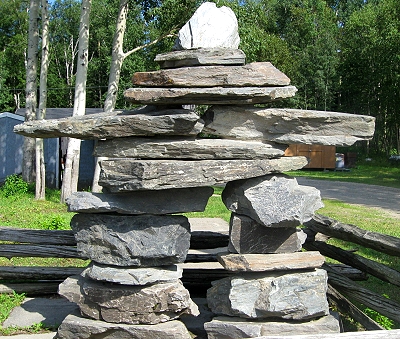
Later, with some asking around, we got the story on the mystery men of stone.
They are called Inunnguaq, a type of Inukshuk that is shaped like a person.
An Inukshuk can be any type of rock marker that the Inuit people have used for centuries from Alaska to Greenland.
They serve as guideposts for travel, or mark spots for fishing, hunting, camping or storing food. Most, if not all, of the ones we saw had been built recently by travelers on this lonely stretch of road.

Lonely- that is until we reached the booming burg of Wawa. In these parts a gathering of nearly 3,000 people constitutes quite the metropolis, so Wawa serves as the hub of activity for miles around.
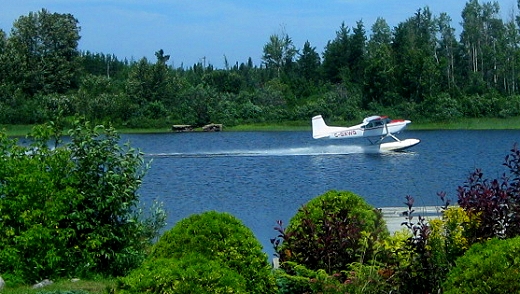
Originally a tiny outpost for fur traders, when gold was discovered in 1896 the town had a boom of growth, but now is best known for the small gaggle of giant geese that call it home. Three to be exact.

Three huge statues of Canadian honkers.
In fact, Wawa means wild goose in the Ojibway language, and that led to the monuments. Back in 1960 the town wanted to erect something to commemorate the completion of the Trans Canada Highway as it met up with highway 101 just outside of town.
What could be better than an enormous goose?

The original was 27 feet high, 23 feet long, weighed 150,000 pounds, and made of chicken wire and plaster.
We’re not sure what they were thinking, because not surprisingly the first winter about ruined it.
Obviously some stronger materials were needed.
So the town raised some money and in 1963 a slightly bigger steel model took a stand at the highway junction.

The wounded original was stashed away out of the elements until 2000 when Mickey Clement refurbished it and found it a new perch at Young’s General Store.
Young’s is quite the attraction itself.
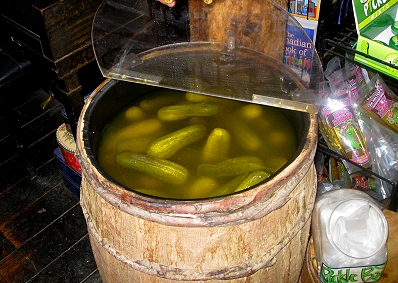
Antiques, curios and memorabilia are intermingled with all sorts of olde timey products throughout the store.
This makes for a way more than the average crap shop.
Perhaps the centerpiece is the giant pickle barrel by the front door. No way we could visit without fishing one of those babies out.
WATCH: Check out the pickle-mania at Young’s!

On the porch Harriet the Moose stands at the ready for photo ops.
So we finally found a moose, but Veronica wasn’t willing to accept this as success since Harriet was no longer a living being, and therefore must be a fake.
We hung around Wawa for a couple of weeks, camping beside The Magpie River, because the area seemed so dad-blamed moosey.
We hiked and biked through the woods and found pastoral ponds and wondrous waterfalls, but not one sign of moose.
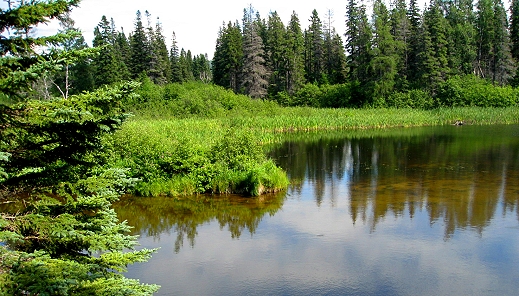

Several times we heard tell of sightings, or tracks spotted by the water, and were told to go out looking at sunset.
So every evening as sundown approached we’d mount up on our trusty bikes and ride out in search of the largest member of the deer family.
All we ever spotted were fish and fowl though.

Speaking of fowl, we don’t want to leave out the third and smallest of the Wawa geese at the Wawa Motor Inn.
It dates back to 1961 when the lodge was built and everyone in Wawa seemed to be in a goose frenzy.
Having gandered at plenty of geese, and still no live moose, we made our way south to Lake Superior Provincial Park. That sounded like the kind of place a moose might want to live to us.


What we found was more interesting than any Bullwinkle, amazing pictographs drawn by the Ojibway hundreds of years ago on Agawa Rock.
The rock is a sheer cliff right on the water so canoe is the ideal method of viewing, but the wind and waves would have none of that on our visit. Instead we walked out onto a narrow sliver of rock along the base of the cliff for a peek at the pictures.

Luckily the park has put some ropes and handles to grab hold of, otherwise the waves would have washed us out into the freezing depths of the big lake they called Gitche Gumee.
Even with the hand-holds we were soaked by crashing waves every few minutes, but the sight was worth the chilly dousings.

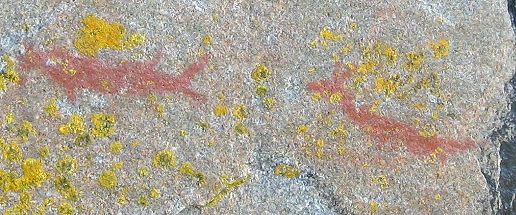
One set of drawings tells the story of a raid across the lake on The Iroquois, others acknowledge different clans, and some are tributes to important spirits.
We spotted another moose in one of the pictographs, but no way was Veronica going to count that.
Unfortunately, it was as close as we were going to get on this trip.
The time had come to admit defeat and start moving south before the weather turned. But only defeat for this one battle, not surrender to the forces of the moose-cuses.
No, we will live to fight another day in the struggle to spot a live moose.
David & Veronica, GypsyNester.com



I found your website from Google as well as I have to state
it was a fantastic find. Many thanks!
Well you may have failed to spot a moose, but who needs them when you have giant geese! I hope lots of cheesy photographs were taken.
Oh yes, many a cheesy pic was snapped!
I have been canoeing Quetico Provincial Park since I was in high school. On a couple trips up there we would routinely see 4-6 moose during the week. Took a hiatus for a decade and got back up there the following two summers in 2010 and 2011. Did not see one moose. I hear their population has dropped.
It might be a cyclical thing that ties in with the wolf population. The wolf population is way up right now, so that could be why the moose population is down. A lot of people these days are looking for moose in Minnesota and Canada and not finding them.
Saw my moose in Alaska.
I’ve seen them up there too, but Veronica has never been there.
Even though Veronica didn’t see a moose, you found many other fascinating sights. Next time, go to Glacier National Park. I saw my first moose there last week while hiking with Road Scholar.
Hmmm, sounds a lot like another moose-cuse to me! 😉 -Veronica